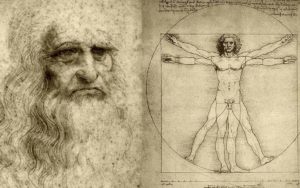
Leonardo’s self-Portrait and his “Vitruvian Man”
Born in the Tuscan hill town of Vinci on April 15, 1472, the oldest illegitimate son of a promiscuous wealthy notary and a peasant, Leonard was a polymath. His interests included invention, painting, sculpting, architecture, science, music (both performing and composing), mathematics, engineering, literature, anatomy, geology, astronomy, botany, writing, history, and cartography.
According to Wikipedia, “many historians and scholars regard Leonardo as the prime exemplar of the ‘Universal Genius’ or ‘Renaissance Man’, an individual of ‘unquenchable curiosity’, and ‘feverish inventive imagination.’ Art historian Helen Gardener confirmed that the scope and depth of his interests were without precedent in recorded history, and ‘his mind and personality seem to us superhuman, while the man himself mysterious and remote.” He epitomized the Renaissance humanist ideal.
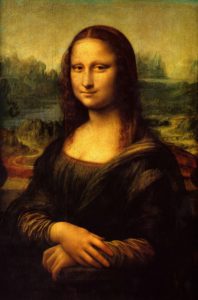
The Mona Lisa
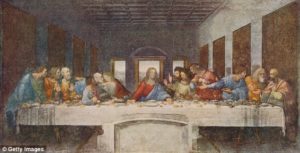
The Last Supper
Of all his talents Leonardo, was, and is renowned primarily as a painter. His two most famous works are the enigmatic portrait Mona Lisa, today in the Louvre, and his “fresco” of The Last Supper in the Church of Santa Maria delle Grazie in Milan, which is the most reproduced religious painting of all time. Not to overlook his drawing the Vitruvian Man, which is also regarded as a cultural icon and, like the Mona Lisa, reproduced on everything from T-shirts to the 1-euro coin.
Over the years Leonardo worked in Florence, Bologna, Cesena, Venice, and Rome before King Francis I lured him to France where he died after less than two years in 1519. He’d lived in Rome for only three years, from September 1513-1516, so I was surprised when The Leonardo Da Vinci Experience, the news hook of this article, opened near St. Peter’s Basilica at Via della Conciliazione 19 in mid-February, to discover, that there were another two permanent “museums” devoted to Leonardo here. One, “Leonardo Da Vinci: The Genius and the Inventions”, is housed in the earliest Renaissance palace in Rome, the Cancelleria. Once the Papal Chancellery and still Vatican property, it’s off Corso Vittorio Emanuele II. The other, The Leonardo Da Vinci Museum, is in the Church Santa Maria del Popolo in Piazza del Popolo. This Head Augustinian Church, home to works by Raphael, Bernini, Caravaggio, and Pinturicchio, besides being a pilgrimage site for the Knights Templar, also marks the site of the Holy Inquisition and, according to legend that of the Emperor Nero’s tomb. I put the word museum in quotation marks because neither of these house original works by Leonardo. In all fairness neither does their new competitor, like them definitely a touristic money-making venture, except that its paintings are exact reproductions of 23 of Leonardo’s paintings using the exact same chemically recreated paints and old wood panels like their originals, when not canvasses.
I visited all three “museums”, the newest first and then the other two for comparison. The six rooms of the new “Experience”, near the Vatican cover The Last Supper, if sketchily, and Leonardo’s flying machines: among them the anemoscope, glider, and parachute; his armaments: armored car, fragmenting bomb, multi-barreled cannon, self-supporting safety bridge, and spoon-shaped catapult; his optical and musical inventions: perspectograph, double flute; his mechanical achievements: the life buoy, dredging machine, odometer, lifting jack, and bicycle; and his paintings. The objects, scaled in size, some of which have never been reproduced before, are explained in Italian, French, English, Spanish, and German, with the codex with Leonardo’s description and drawings cited since he left no models of his inventions, and all are hands-on for the delight of children.
“The painting section,” Leonardo La Rosa, the General Manager, told me, “is a work-in-progress. We still have to finish the audio-guide, but it’s already possible to compare his two versions of The Madonna of the Rocks, one in thee Louvre, the other in London’s National Gallery and of The Madonna of the Yarnwinder, one in Edinburgh, the other in a private collection in New York.”
When I asked La Rosa the point of a third Leonardo “Museum” in Rome, he pointed out that 2016 was the 500th anniversary of Leonardo’s leaving Rome for a quiet retirement in France and that 2019 would be the 500th anniversary of his death.
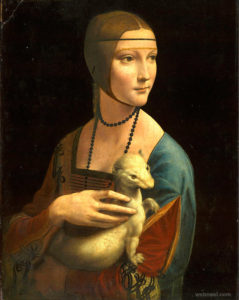
The Lady with an Ermine
Opened in 2009, “Leonardo Da Vinci: The Genius and His Inventions” presents 51 full-scale machines, built by a group of academics and skilled craftsmen in Florence after in-depth study of Leonardo’s codices. Models of the oil press, the carillon, hygrometer, giant crossbow, prototype for the machine gun, plus a man wearing the life buoy and webbed gloves are displayed only here. Out of choice there are no paintings here except a hologram explaining The Last Supper, Mona Lisa, and The Lady with the Ermine, which was reportedly added later. Pluses include excellent explanations in Italian, English, French, Spanish, and German, wheelchair accessibility, an elevator, and restrooms.
Grande Exhibitions’ permanent Leonardo Da Vinci Museum in Santa Maria del Popolo opened in 2010. Like its new competitor it has six underground rooms divided by category with hands-on models, but it offers many more models, an assault ladder, a covered cart for attacking fortifications, scuba diving equipment, a hydraulic saw, portable piano, for examples, and an all-inclusive audio-guide in Italian, English, French, Portuguese, and Spanish. Moreover, its wall panels in Italian and English have much more detailed explanations and the displays the additional categories of Leonardo’s codices, a model of his ideal city, his anatomical drawings and his fresco of The Battle of Anghiari for Florence’s Palazzo Vecchio, as well as videos about Leonard the sculptor and about his Last Supper, which included some details I’d never heard before: that this was the earliest work-of-art with the apostles showing emotion and with Judas sitting at the table with them instead of alone. The Museum’s main weaknesses are its faded photographs of Leonardo’s paintings with just their titles, but no explanations, and no bathrooms or accessibility for the disabled.
But, to return to Leonardo and Rome, where he came at the behest of Giuliano de Medici, Pope Leo X’s brother and commander of the papal troops. During his three-year stay, when he spent most of his time in the Belvedere of the Vatican, www.sparknotes.com reports that Leonardo “pursued architecture, hydraulics, and the dynamics of mirrors. Moreover, at this time the Medici empire’s fortune depended largely on the dye industry and Leonardo attempted to fashion a parabolic solar reflector that would speed the boiling process essential to the making of dyes.”
Artistically speaking, in Rome Leonardo drew his well-known self-portrait as an old man, remarkable because it was drawn from an angle and not head-on so Leonardo had probably arranged a complex system of mirrors to draw himself from this angle. In addition he completed his last major painting, Saint John the Baptist, now in the Louvre.
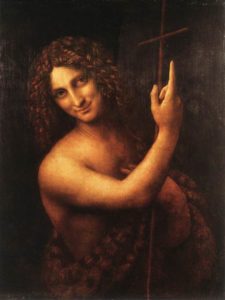
St. John the Baptist
Instead, Ritchie Calder, in his biography Leonardo and the Age of the Eye, recounts that Leonardo “was definitely working on some elaborate device (mirror telescope?), which was so secret that he would not trust his ideas to craftsmen, but was designing his own machines to grind and polish lenses”, while Leonardo La Rosa told me that Leonardo worked on his plans for draining the Pontine Marshes, south of Rome, and on those for the Port of Civitavecchia.
Nonetheless, in spite of all this activity, according to Vasari, Leonardo was bored and unhappy in Rome, because Pope Leo X preferred Michelangelo. The more likely reason for Leo’s X’s cold shoulder is that Leonardo was interested in necromancy. This may also help to explain why for certain there is only one painting of his in the Eternal City, with a second recently attributed to him.
Dating to c. 1480 so not painted in Rome and left unfinished, Leonardo’s St. Jerome in the Wilderness, now in the Vatican Museums, probably remained in the artist’s possession until his death. According to the Vatican Museums’ website, it was first mentioned and attributed to Leonardo in the will of the painter Angelica Kauffmann (1741-1807). “On Kauffmann’s death all trace of it disappeared, until it was found by chance and purchased by Napoleon’s uncle, Cardinal Joseph Fesch. According to tradition the cardinal discovered the painting divided into two parts: the lower part in the shop of a Roman second-hand dealer where it formed the cover of a box, and that with the head of the saint at the shop of his shoe-maker who had used it to make the cover of his stool. Over and above the story, the painting can really be seen to be cut into five parts. On the death of the cardinal the picture was auctioned and sold a number of times until it was identified and purchased for Pius IX (pontiff from 1846 to 1878) for the Vatican Pinoteca (1856).”
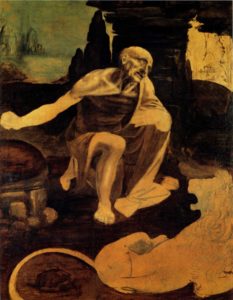
St. Jerome in the Wilderness
Another painting in Rome has recently been attributed to Leonardo. It’s The Adoration of the Christ Child in the Borghese Gallery, previously attributed to Fra Bartolomeo. After a recent cleaning the Borghese Gallery sought attribution as a work of Leonardo’s youth based on the presence of a fingerprint similar to one that appears on The Lady with the Ermine, now in Krakow. The results of the Gallery’s investigation are not yet published.
On until April 17th in Rome’s Capitoline Museums is a temporary exhibition about Leonardo’s Codex on the Flight of Birds. In this handwritten from right to left 18-page notebook on loan from the Royal Library in Turin Leonardo wrote and illustrated his studies on the flight of many species of birds along with wind resistance and currents. It’s likely that page 10v features a hidden self-portrait.
For nearby Epicurean treats:
Nearby the Vatican:
On the narrow medieval pedestrian street, Borgo Pio, is the popular family-run, good-value bistrot Arlù. Its onion-soup and Roman dishes are delicious, but be sure and leave room for dessert.
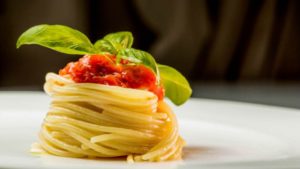
Spaghetti Don Alfonso
Uphill from the Vatican on the slopes of the Janicuulm, but worth the 5-minute walk, is romantic Viva Voce in the luxurious Gran Meliá Hotel. The owner of the iconic Ristorante & Hotel Don Alfonso 1890 on the Amalfi Coast with 2 Michelin stars as well as restaurants in Marrakesh and Macao, Alfonso Iaccarino, responsible for putting southern Italian cuisine on the world map, is menu consultant here.
Nearby the Cancelleria:
Just across the avenue Corso Vittorio Emanuele II at no. 165, tel. 06-64760447(for home deliveries and party catering) is V.I.P Very Italian Pizza. From the outside it looks like every other scruffy pizza-by-the slice joint with only four seats at a counter, but here the pizza and the wide choice of its toppings is to-die-for, not to mention the calzone, supplì, and olive ascolane.
A block away overlooking the Mercato de’ Fiori, Rome’s oldest and most famous outdoor vegetable and fruit market, is La Carbonara, famous for its typically Roman cuisine.
Nearby Piazza del Popolo:
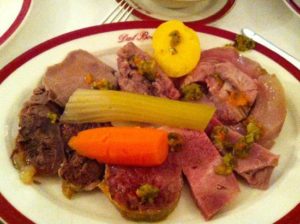
Dal Bolognese’s Bollito Misto
High-end and elegant Dal Bolognese, right on the piazza itself, has long been first-rate for its food and for people-watching. Its bollito misto is unforgettable.
Just off the piazza on Via del Babuino in Rocco Forte’s five-star historic Hotel De Russie is Le Jardin de Russie, an oasis in chaotic downtown Rome. Top-chef Fulvio Pierangelini is “The Creative Director of the Kitchen”.
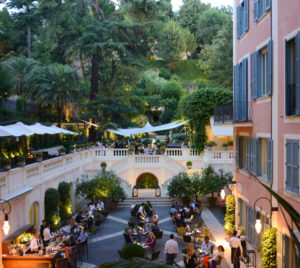
Le Jardin de Russie
On the Capitoline Hill:
Located on the top floor of the beautiful Renaissance palace with its same name that houses half of the Capitoline Museums, but also accessible from outside, is the Terrazza Caffarelli. With its magnificent view over the city center it’s the perfect place for an aperitivo at sunset. To rent for private parties contact Neva Angeletti, External relations Manager, at eventi@terrazzacafferelli.it, tel. 011-39-0666510570 or cell. 011-39-393-8723780.
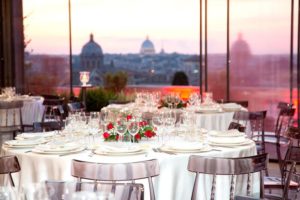
La Terrazza Caffarelli
